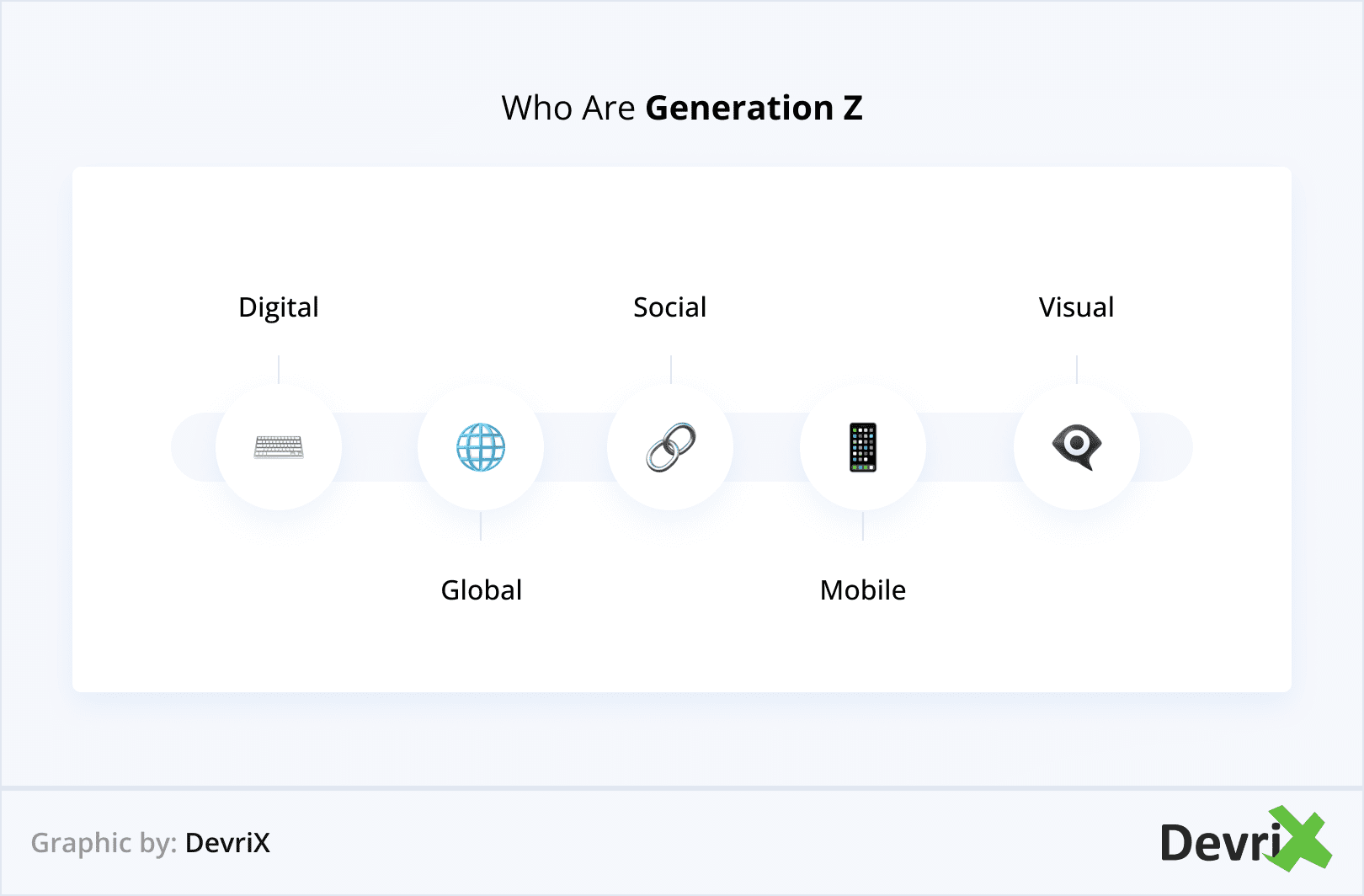With a population of 2.56 billion Gen Z individuals, accounting for 26% of the global population, and a collective spending power of $143 billion, Gen Z represents a highly gainful market. Moreover, their digital savviness and unique expectations drive innovative trends and experiences and will hugely impact eCommerce brands in the near future. In the US, 96% of Gen Z consumers reported shopping online at least once a month in the first quarter of 2023.
For eCommerce brands, capturing Gen Z’s attention is vital. Let’s look at some ways to adapt to their tech-savvy shopping habits and engage them with our strategies.
Who Are Generation Z?
Generation Z, often referred to as Gen Z or Zoomers, represents those born between the mid-1990s and the early 2010s. Gen Z is known for being diverse, socially and environmentally conscious, entrepreneurial, and adept at multitasking in the digital realm. This generation shares five main characteristics:

- Digital. Gen Z have naturally incorporated technology into their lives. Growing up with it from a young age, it has become an essential part of their lifestyle and relationships, akin to the air they breathe.
- Global. Gen Z is living in a world of globalization. Their music, movies, and celebrities transcend borders, all thanks to technology and cultural diversity.
- Social. Social media plays a huge role in expanding their network, both in size and geographical. Being technology-driven, Gen Z connection is constant, 24/7.
- Mobile. Not only are Gen Z mobile in terms of using technology constantly, they are also moving homes and jobs faster than ever before. Today’s high-school graduate is expected to have 18 jobs across 6 careers.
- Visual. With almost 5 billion videos watched on YouTube alone every day, Gen Z prefers to watch a video summarizing an issue rather than reading an article discussing it.
Readers Also Enjoy: How Brand Recognition Helps You Improve Customer Retention – DevriX

As consumers Gen Z are characterized by their digital fluency, diversity, and socially conscious mindset. They value authenticity, individuality, and inclusivity, gravitating towards brands that align with their values. Gen Z expects personalized experiences, technology integration, and a strong commitment to sustainability and social responsibility from the brands they engage with.
That said, Gen Z and Millennials share similarities in their shopping preferences such as opting for a combination of in-store and online experiences driven by convenience, safety, and price comparison.
However, a significant distinction lies in their economic circumstances. While Millennials have witnessed economic growth during their coming of age, a good number of Gen Z are maturing in a post-pandemic era, well aware of the financial strains faced by their parents and peers. Given their uncertain relationship with money, they seek a balance between affordability and their purchasing decisions being socially and environmentally conscious.
The following strategies meet the unique characteristics and expectations of Generation Z when it comes to eCommerce brands.
1. Embracing Authenticity and Purpose
Authenticity and purpose-driven values hold significant importance for Gen Z. Here’s why:
Identity and Individuality.
Gen Z values authenticity because they seek to express their unique identities. They appreciate brands that are genuine, transparent, and true to their values, as it resonates with their own desire to be authentic.
Social Impact.
Zoomers are known for their strong social consciousness. They prioritize brands that actively support sustainability, diversity, and inclusivity, and align with their own desires to make a positive impact on the world.
Engagement and Loyalty.
Gen Z craves meaningful connections with brands. They are more likely to engage and remain loyal to brands that genuinely care about their customers and society.
Influence and Influenceability.
Gen Z strongly influences consumer trends and brand perceptions. They actively share their opinions and experiences through social media, impacting their peers’ purchasing decisions. Brands that are authentic and socially aware are more likely to earn their endorsement and positive word-of-mouth.
How to Communicate Your eCommerce Brand Purpose Effectively?
1. Clearly define your brand purpose and ensure it aligns with Gen Z core values.
This should be consistently reflected in your brand messaging, visuals, and overall customer experience.
2. Utilize storytelling techniques.
Storytelling techniques can humanize a brand and form emotional connections with the audience. Sharing real-life success stories or testimonials can illustrate how your brand’s purpose positively impacts customers’ lives.
3. Leverage social media platforms and influencer collaborations.
This will amplify your brand’s purpose and engage a wider audience. Finally, brands should actively engage with their customers, seeking feedback and implementing transparent practices that build both trust and credibility.
2. Mobile-First Approach

Gen Z’s mobile-first mindset demands user-friendly experiences, compelling brands to optimize websites and apps for mobile platforms. Mobile advertising, influencer marketing, and personalized mobile notifications are key strategies to capturing their attention. To effectively engage with Gen Z, prioritize mobile optimization, responsiveness, and create captivating mobile experiences.
Readers Also Enjoy: How to Speed Up Your WordPress Website and Boost Loading – DevriX
5 Tips for Creating Seamless Mobile Experiences
- Optimize Page Load Speed. Mobile users expect instant access to information. To achieve fast load times, minimize file sizes, compress images, leverage browser caching, and use content delivery networks (CDNs) to reduce server response time.
- Use Responsive Designs. Implement responsive web design to ensure that your website adapts and displays appropriately on different screen sizes. This eliminates the need for users to zoom in or scroll horizontally, providing a smooth and intuitive browsing experience.
- Simplify Navigation. Use clear and concise menus, minimize the number of clicks required to access information, and provide prominent search functionality. Organize content logically and ensure that important elements are easily accessible, such as shopping carts or contact forms.
- Implement Mobile-Friendly Forms. Streamline the process by minimizing the number of form fields and using autofill and predictive text features. Utilize mobile-friendly input methods like checkboxes, radio buttons, and dropdowns, making it easy for users to provide information without excessive typing.
- Conduct User Testing. Regularly test your mobile experiences with real users to identify pain points and areas for improvement.
3. Social Media Engagement
Because they tend to have a strong digital presence, Gen Z rely on social platforms for information, inspiration, and social validation. They engage with brands, influencers, and peers on platforms like Instagram, TikTok, and Snapchat. Social media often affects their purchasing decisions through product recommendations, user-generated content, and influencer endorsements.
How to Effectively Leverage Social Media and Engage With Gen Z Customers?
As already mentioned, authentic and relatable content as well as influencer marketing should be your top priorities. However, in addition to that, you should also take note of the following practices:
- Offer Interactive Experiences. Incorporate interactive elements such as polls, quizzes, challenges, games and contests to encourage participation and create a sense of fun and excitement. This not only boosts engagement but it also increases brand awareness and affinity.
- Social Listening and Engagement. By actively listening to and interacting with Gen Z’s and their conversations on social media platforms, you demonstrate that you value their opinions. Remember to respond promptly, be genuine, and use a conversational tone that fosters a meaningful connection and builds trust.
- Seamless Shopping Experiences. Make it easy for Gen Z to shop directly from your social media platforms. Utilize features like shoppable posts and links to product pages. Streamline the buying process, provide clear product information, and offer secure payment options to ensure a seamless shopping experience.
4. Personalization and Customization
Gen Z has a strong preference for personalized and unique experiences. Here’s a few tips on how to meet this expectation:
- Customization. Gen Z craves tailored experiences. Brands should offer personalized recommendations, product customization options, and targeted promotions that meet their individual preferences.
- Individuality. Brands that celebrate uniqueness, inclusivity, and diversity resonate with them.
- Limited Editions and Exclusivity. Launching unique products that are limited or limited time offers creates a sense of urgency, driving engagement and purchase decisions.
- Immersive Experiences. Create interactive pop-up stores, virtual events, and augmented reality features that provide memorable and engaging encounters.
- Co-creation and Co-design. Involve Gen Z in the creation process. Seek their input, feedback, and/or ideas on products, services, or campaigns. This fosters a sense of ownership and deepens their connection with the brand.
Don’t forget the data-driven personalization for eCommerce brands. It is vital to better understanding the customer experience, boosting conversion rates, improving customer retention, reducing cart abandonment, and optimizing marketing efficiency. By leveraging your customer data, you can tailor your offers, recommendations, and promotions, creating a more relevant and engaging shopping experience for Gen Z.
Readers Also Enjoy: Тop 22 Common UX Mistakes [And How to Fix Them] – DevriX

5. Seamless and Secure Checkout Experience
User-friendly interfaces, intuitive navigation, and transparent payment options are essential elements for a successful online shopping experience.
Here’s what they offer and why they are important:
- User-Friendly Interfaces. Clear, organized layouts, intuitive design elements, and straightforward navigation that make it easier for Gen Z consumers to find products, access information, and complete purchases.
- Intuitive Navigation. Intuitive navigation ensures that the browsing experience is effortless and that the user can easily navigate product categories, search for items, and access key information without confusion or frustration.
- Transparent Payment Options. Gen Z appreciates straightforward payment methods, transparent fees, and security measures. Offering trusted payment gateways, secure SSL encryption, and transparent pricing enhances their perception of safety and encourages them to complete transactions.
Trust signals, secure payment gateways, and robust data protection measures play a crucial role in establishing trust and confidence in online transactions:
- Trust Signals. Trust signals such as customer reviews, ratings, testimonials, and trust badges instill confidence in Gen Z consumers making them more likely to engage and complete purchases.
- Secure Payment Gateways. Implementing trusted payment gateways with industry-standard security measures protect sensitive customer information, such as credit card details, from unauthorized access. This helps promote trust while reducing concerns about fraud and identity theft.
- Robust Data Protection. Gen Z values their privacy and expects brands to prioritize data protection. Implementing robust security measures, such as encryption, secure server protocols, and compliance with data protection regulations shows a commitment to safeguarding customer data. This instills confidence and trust in the brand.
Wrap Up
To capture Gen Z’s attention and boost eCommerce brands, you must be proactive. They should embrace Gen Z’s love for social media, be transparent and socially responsible, offer unique experiences, and prioritize mobile-friendly websites. That’s the key to winning over Gen Z and succeeding in eCommerce!ecommerce




